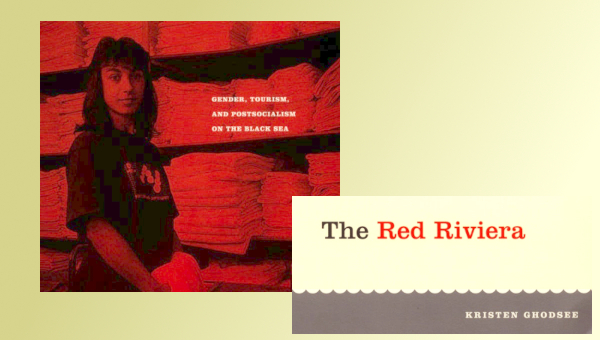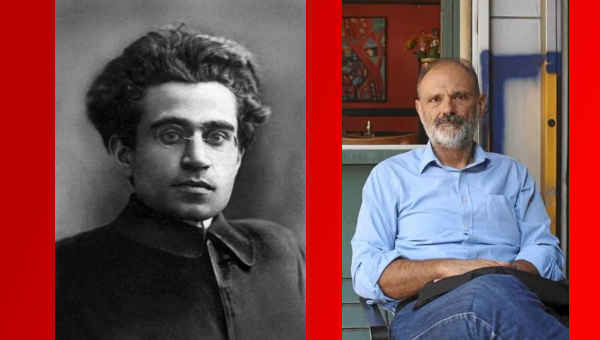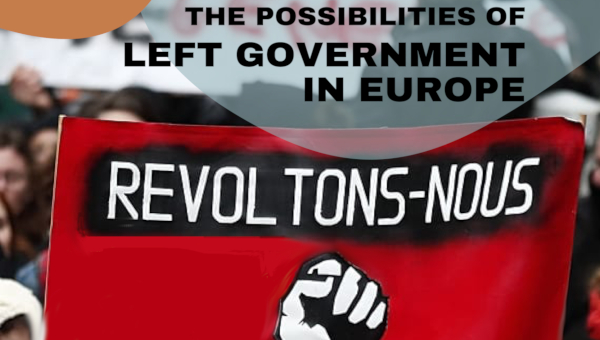How Socialists Resist Rightist Coups: Lessons from the Early Communist International
Parliaments and elections are no guarantee of democratic rights and fair treatment for working people. Capitalist forces displeased with an electoral outcome are all too likely to take direct action to impose their will, whether by financial manipulations, economic blockades, or military coups.
Even apparently stable parliamentary regimes in dominant countries can be challenged in this way. So it was that a military revolt brought down the French Fourth Republic in 1958 and, in 2020-21, Donald Trump mounted a campaign including an apparent coup attempt aiming to overturn the outcome of the US presidential election.
Socialists are challenged to actively oppose rightist coup attempts without lending support to any wing of the ruling capitalist class.
This challenge has come up repeatedly during the history of socialism. Let us survey a portion of the record: the Russian revolution of 1917 and the experience in Europe during the next six years. During this period, the workers’ movement in Europe faced four major rightist coup attempts:
- Attempted Kornilov coup in Russia, September 1917.
- Kapp Putsch in Germany, March 1920.
- Fascist seizure of power in Italy, 1920–22.
- Military coup in Bulgaria, 1923.
The outcome was mixed: a historic victory, a standoff, and two stinging defeats.
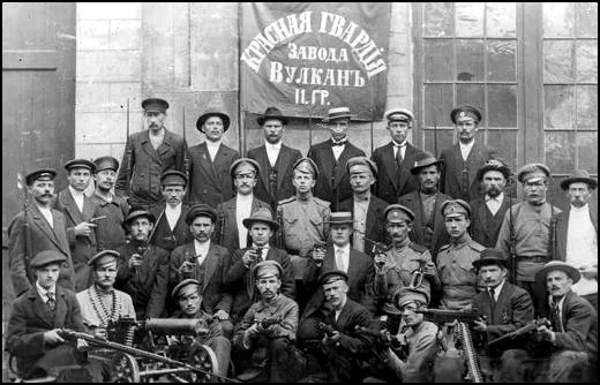
1917: Uniting Against the Kornilov Coup
In the first days of September 1917 (new style), during the seventh month of the Russian revolution, General Lavr Kornilov, the head of the Russian army, sent army divisions to occupy Petrograd (St. Petersburg) in order to depose the Provisional Government, disperse the workers’ and soldiers’ soviets, hang Lenin and other soviet leaders, and assume power.1 The government, headed by Alexander Kerensky, had been installed by the Soviets and represented an alliance of bourgeois and pro-coalition workers’ parties. Resisting Bolshevik calls to grant “all power to the Soviets,” this government had jailed Bolshevik leaders such as Leon Trotsky and driven V.I. Lenin into hiding.
When Kerensky dismissed Kornilov on September 10, the general shifted his coup into high gear. On September 11, the Petrograd Soviet, composed of delegates from workers’ and soldiers’ councils, set up a Committee for Struggle Against the Counterrevolution. Its 18 members included representatives of all major currents in the soviets, ranging from pro-government forces to Bolshevik representatives. The Committee for Struggle mobilized workers, formed armed detachments, rallied soldiers , and boldly infiltrated the ranks of Kornilov’s divisions. Two days later the coup collapsed without a shot being fired.
By confronting Kornilov, the Bolsheviks, the driving force in the Committee for Struggle, were defending the very government that was throwing its leaders in jail. The anti-Kornilov alliance defeated Kornilov quickly and efficiently, while maintaining its independence from Kerensky’s regime. On the shoulders of this victory, a month later the forces that joined to defeat Kornilov led in the transfer of formal political authority to the Soviets, brushing aside the Provisional Government in the process.
The Kornilov episode provided a textbook example of how to unite working-class and allied forces in action against a rightist coup. Even so, it was rarely mentioned in subsequent debates in the Communist International (Comintern). In 4,500 printed pages of Comintern world congress and Executive Committee (ECCI) plenum proceedings up to the end of 1922, resistance to Kornilov is mentioned only once, without explanation.2 Another passing reference is found in Lenin’s celebrated pamphlet written in 1920, “Left-Wing” Communism, an Infantile Disorder. Only at the 1923 ECCI plenum, a few days after a disastrous rightist coup in Bulgaria, did the Kornilov experience receive several mentions.3
Founding the Third International
The Russian Soviet Republic was established in November 1917 with an internationalist mission: to end the disastrous imperialist world war and to spread the message of socialist revolution across Europe. A year later, the emperors of Germany and Austria-Hungary were ousted by uprisings of workers and soldiers, whose revolutionary councils initially exercised wide authority. Their rebellion brought the war to a rapid end. Workers’ struggles swept all of Europe. The time was ripe to re-knit unity among internationalist socialists across the continent.
In December 1918, the Russian Communist Party sent a radio message to revolutionary socialist groups abroad calling for formation of a revolutionary Third International. This appeal was repeated in a further statement, sent by courier later that month and signed by Lenin and Trotsky, on behalf of Russian Communists, and by representatives in Moscow of socialist parties in seven other countries.4
During the three months before the conference convened, the workers’ councils in Germany came under fierce attack. The SPD-led government summoned monarchist and proto-fascist militias to attack the councils. Thousands of workers were killed, including Communist leaders Karl Liebknecht and Rosa Luxemburg.5 The bourgeois “Weimar Republic” that now ruled Germany was parliamentary in form, but its structures were dominated by partisans of the fallen imperial order.
Yet the defeat suffered by German workers was not definitive. The German workers’ councils, though weakened, still existed. Across Europe, the revolutionary upsurge continued to advance amid conditions of postwar economic and social disintegration.
The founding congress of the Communist International met in Moscow on 2 March 1919. The 51 delegates, representing 22 countries, were confident that the movement for workers’ power, based on the newly formed workers’ councils, was sweeping toward continent-wide victory. Lenin expressed this hope in an article published on March 5:
“The German revolution has provided the test… [N]ot only the same principal revolutionary forces and principal directions of the revolution, but also the same principal form of the new, proletarian democracy – the soviets…
The ice has been broken.
The soviets have triumphed throughout the world…
The new movement is heading for Soviet government with the torrential might of millions and tens of millions of workers sweeping everything from their path.”6
The Moscow congress concluded March 6 by launching the Communist International (Comintern) as a new world movement of world socialist revolution. Its main resolution counterposed “bourgeois democracy and the dictatorship of the proletariat,” seeking to rally forces to achieve a revolutionary government based on workers’ councils. Another congress statement, after denouncing the rise of “white terror” across Europe, called on workers “to abolish this system of murder and robbery by overthrowing the power of the capitalist regime.”7
The congress was preliminary in character; it did not attempt to elaborate a program. Luxemburg had expressed the outlook of many Communists three months previously to delegates at the founding congress of the German Communist Party (KPD) in terms of a break from the programmatic approach of the pre-1914 German Social Democratic Party (SPD):
“In deliberate contrast to [the SPD’s 1891 Erfurt program], we are settling the accounts of the last seventy years of development, and of the immediate results of the World War in particular, that we no longer have a minimum and maximum program. Socialism is both at the same time – it is the minimum that we have to accomplish today.”8
The Comintern swiftly moved beyond this conception. During the years after its foundation, the Second, Third, and Fourth congresses sought to craft a single, integrated system of immediate, democratic, and transitional demands.
Repelling a Rightist Coup: The Kapp Putsch of 1920
Shortly after the Comintern’s founding congress, revolutionary Communist-led governments, based on local workers’ councils, took power in Hungary (late March) and the German state of Bavaria (April). Both governments were overwhelmed by fierce capitalist military attacks. The newly born Comintern tried to rally active solidarity with these regimes but with only limited success. The workers’ governments were overthrown in May (Bavaria) and August (Hungary).
In both cases, the triumphant rightists carried out murderous reprisals. Hungary was subjected to a reactionary military dictatorship; Bavaria became a stronghold of proto-fascist forces hostile to the German Weimar Republic.
In Germany, many monarchist and proto-fascist currents sought to replace the Social Democratic-led parliamentary regime with a direct rightist tyranny. On 12 March 1920, German army detachments aligned with the Bavarian rightists seized the capital, Berlin, and proclaimed a new military-led government, led by Wolfgang Kapp. The elected regime was forced to flee. At dawn the following day, the SPD-led unions called for a general strike against Kapp’s putsch. The strike was massively successful, shutting down the country and isolating the coup regime, which collapsed on March 17. For more on resistance to the Kapp Putsch, see part iii below.
Although not unexpected, the rightist eruption caught the German Communist Party (KPD) leadership off balance. The party’s statement, published March 14, refused to take sides in the struggle. In view of the violent attacks on workers by the constitutional regime, the KPD stated, there was no point in defending it against the military putsch. The real struggle was for workers’ power, and that lay in the future.9
Yet despite the KPD leaders’ initial misgivings, the general strike quickly rallied 12 million German workers, shutting down the country and isolating the coup’s leaders. The KPD quickly corrected its error, rallied in support of the strike, and thereafter played a constructive role in the Kapp struggle and its aftermath.
In two of Germany’s industrial heartlands, workers resisting the coup took up arms and gained effective regional control. When Kapp and his cohorts fled (March 17), workers refused to end the strike and demanded decisive action against rightist militias. The head of Germany’s main union federations called for replacement of the Weimar regime with a “workers’ government” formed by all major working-class organizations.
Workers’ resistance to extreme-right violence was beginning to grow over into a bid for workers’ power. The capitalist government and its army responded brutally and soon regained control. Nonetheless, the struggle against Kapp confirmed the lesson of the 1917 Kornilov episode, showing the power and potential of united resistance to rightist bids to replace parliamentary rule with naked tyranny.
The KPD’s initially favourable reaction to the “workers’ government” proposal sparked a controversy among Communist leaders in both Germany and Moscow. Less attention was devoted to the alliance of working-class forces, including the SPD, that had so readily defeated the coup.
The Hazards of ‘Left-Wing’ Communism
The German Communists’ initial blunder regarding the 1920 Kapp Putsch reflected a mood of revolutionary impatience widespread in the International at that time. Communists termed this outlook “left-wing communism”; today it is known as “ultraleftism.”
This danger was addressed by the Comintern’s Second World Congress, which convened in July 1920 four months after the Kapp Putsch. Lenin contributed a celebrated pamphlet, “Left-Wing” Communism: An Infantile Disorder, which was distributed to all delegates on their arrival in Moscow.
Lenin’s pamphlet and the Congress agenda focused on several major errors of the ultraleft currents, including abstention from contesting elections in capitalist states, abstention from reformist-led trade unions, and the failure to support national and colonial liberation movements. In each case, the Congress adopted policies aimed at assembling and educating forces over time to build a mass revolutionary party deeply rooted in the working class. The Second Congress also took major steps toward integrating immediate demands into the Communist program.
A passing reference in Lenin’s pamphlet compared the Kapp experience to Kornilov’s failed anti-soviet putsch in Russia in September 1917. The similarity between the two experiences was truly striking: in both cases united action by revolutionary and reformist currents in the workers’ movement defeated the rightist coup and also created conditions where workers could make a bid for power. However, the parallel was not explained either by Lenin or by any other speaker at the Second Congress.10
All in all, the Second Congress devoted surprisingly little attention to the Kapp Putsch struggles. The main Congress report, given by Comintern President Grigorii Zinoviev, touched on it only briefly. He criticized the KPD for having supported the proposal made during the Kapp struggle for a government of all workers’ organizations but failed to note Lenin’s qualified support for this concept. Neither Zinoviev nor any other congress speaker mentioned the KPD’s initial ultraleft opposition to the general strike or the role of workers’ unity in defeating the Kapp coup. (For more on the congress debates, see “The Comintern’s Second Congress: A Centennial Introduction.”)11
Rethinking the Path to Power
The Second World Congress decisions reflected hopes of an imminent workers’ breakthrough in Central Europe, inspired by the Soviet Red Army’s success in repelling an invasion by Poland. A year later, Trotsky spoke of the mood of those days: “[B]ecause of the revolutionary situation in Germany, Italy, and others, the military impulse … might bring on the landslide of revolution, then temporarily at a dead point. That did not happen. We were beaten back.”12 The defeat of the Red Army in Poland in late August 1920 added to the evidence that capitalism in Europe had restabilized, at least temporarily.
Meanwhile, the rightist dictatorship established in Hungary in 1919 after the fall of the Communist-led regime had shattered working-class resistance and dispersed the Communist movement. In Germany, rightist enemies of the Weimar Republic and reactionary militias remained strong. In Italy, toward the end of 1920, workers’ and peasants’ organizations began to come under violent attack by anti-labour squads, who called themselves “Fascists.”
Part II: Toward a United Front Against Fascism
By 1920, The working-class movement urgently needed to find a road to effective resistance to such rightist threats, including when these assaults took the form of a military coup replacing one capitalist government with another.
The initiative for united working-class action came from the Communists in Germany (see “The Origins of United Front Policy”). On 8 January 1921 the KPD addressed an open letter to all other major workers’ organizations, proposing common action around nine demands, representing goals that the entire workers’ movement held in common. The first two goals set the tone: wage struggles on behalf of all workers and increased pensions. One of the demands addressed the threat from far-right enemies of the Weimar Republic:
“7. Disarmament and dissolution of armed bourgeois detachments and formation of workers’ self-defence organizations.”13
Conceptually, the Open Letter was in one sense a return to the spirit of the Erfurt Program rejected by Rosa Luxemburg in December 1918. It offered a “minimum program” of immediate goals to be set alongside the revolutionary objective of overthrowing capitalist rule and establishing a government of workers’ councils. But the Open Letter posed the action program in a novel way – as a platform for an alliance of all major workers’ organizations.
Leaders of the SPD and other major workers’ organizations rejected the KPD’s Open Letter initiative. Nonetheless, German Communists pursued this approach, winning significant rank-and-file support. Later that year the Open Letter approach was endorsed by the entire Comintern. The International’s call for the united front, on Lenin’s suggestion, incorporated a thesis on Bolshevik experience of unity with the rival Menshevik movement in 1917 and before. Inexplicably, this thesis did not mention the Kornilov events.14
The new policy, named “united front,” was pursued for three years with some success.
For example, on 26 August 1921, a leading German bourgeois politician and opponent of the working class, Matthias Erzberger, was assassinated by an extreme rightist current. The Communists joined in building the massive popular protests that followed. They played this role again during the outpouring of rage following the similar assassination on 24 June 1922 of another prominent bourgeois statesman, Walter Rathenau. On this second occasion, the KPD proposed a series of measures by the German government to strike down the ultra-rightist, fascist, and proto-fascist groups advocating violence against the Republic.15
The KPD’s energetic efforts to build the Erzberger and Rathenau protests displayed a broad and inclusive conception of the united front. Even some bourgeois forces on occasion could be embraced in anti-fascist actions, while taking care not to surrender working-class political independence.
Resisting Italian Fascism
The next major assault on workers’ democratic rights emerged through the rise of Fascism in Italy in 1921–22. Led by Benito Mussolini, the Fascists waged a brutal war against worker organizations, with covert support of the police and army, before finally achieving power through the threat of a “March on Rome.”
Fascism was then a new phenomenon, and the Comintern had not yet worked out an appropriate response. The Italian Communist Party, formed in January 1921, stood opposed to broad united action against fascism, and the International’s leadership in Moscow did not insist on the need for a correction. The default by Italian Communists helped smooth the Fascists’ road to victory, a disastrous setback for the workers’ movement.
On October 30, 1922, five days before the opening of the Comintern’s Fourth World Congress, Benito Mussolini assumed power in Italy. Congress delegates from several front-line parties pointed to the need for a united-front response. Moments before the congress closed, Zinoviev declared, “We must succeed in becoming a vanguard of the entire anti-fascist struggle.” Soon after the Congress adjourned, the Comintern Executive Committee clarified that the needed defense should take the form of a united front.
But just what was it that the Comintern sought to defend against Fascism? Workers and their organizations needed physical defence from Fascist attacks of the working class, to be sure, but more was involved. The Erzberger and Rathenau campaigns had protested the murder of a capitalist politicians hostile to the working class. United fronts against the Kapp Putsch and earlier – in Russia – against the Kornilov putsch in 1917 had blocked efforts by the extreme Right to overthrow capitalist governments that were themselves repressing the working class. A Comintern campaign in 1922 on Austria defended, among other things, the sovereignty of this bourgeois republic.
Yet, in Germany, the brutal counterrevolution of 1919 that numbered Luxemburg and Liebknecht among its thousands of victims had been carried out under the banner of parliamentary democracy. At the KPD’s August 1922 convention, KPD leader August Thalheimer spoke of “defending the [German] republic against monarchist attacks.” Yet at the Fourth Comintern congress, Karl Radek of the Comintern leadership endorsed criticisms by KPD leader Ruth Fischer of the KPD’s conduct during the Rathenau campaign, saying in the Fourth World Congress that Communists should “not run after the corpse of Rathenau shouting “republic, republic.” Zinoviev spoke in similar terms.
In fact, there was a sharp distinction between defending the democratic rights embedded in the German bourgeois republic against a rightist coup and advocating the Weimar Republic as a form of rule. But unfortunately, the need for united anti-fascist defence was raised too late in the Fourth Congress to explore this question.16
Some years after the Congress, the Italian delegate Camilla Ravera recounted a comment by Lenin on this issue in a meeting with Italian delegates held on the eve of the Fourth Congress. “The working class always struggles to win and defend democratic rights, even if they are limited by the bourgeois government,” she recalls Lenin as saying. “And when it loses them, it fights to win them back, and searches for allies for that struggle.” This account is not echoed by other reports of the 1922 congress, but it is consistent with Lenin’s long-held views and expresses well the core issue before the Fourth Congress delegates.17
Clara Zetkin on Unity Against Fascism
Following the Fourth Congress, the Comintern launched an initiative for united struggle against fascism, which led to an international conference of 250 delegates from a dozen countries in Frankfurt am Main, Germany, on 17–20 March 1923.18
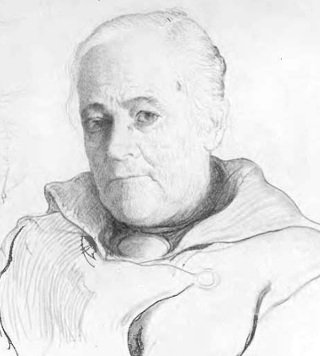
A leading role in these efforts was played by Clara Zetkin, who had helped blaze a trail for united-front efforts in Germany and the International. United resistance against fascism now became the framework in which revolutionary socialists linked up with their pre-1917 heritage of championing democratic rights against all forms of capitalist repression and took broad initiatives against the threat of far-right tyranny.
When the Comintern’s Executive Committee met in an enlarged plenum in Moscow 12-23 June 1923, anti-fascist resistance was a central agenda point, and Zetkin was chosen to give the main report on it.19
The urgency of this report was underlined by news that a rightist military coup in Bulgaria, three days before the plenum, had overthrown the parliamentary-based regime of a left-wing peasants’ party. The Bulgarian Communist Party, widely viewed as the strongest and most experienced outside Soviet Russia, reacted by declaring its neutrality, claiming that the coup represented an internecine dispute within the bourgeoisie in which the workers had no stake.
The Executive Committee plenum sharply condemned the Bulgarian section’s passivity. Zinoviev called on Bulgarian workers to join in struggle against the putsch with the peasant masses led by Aleksandar Stamboliyski and with other leaders of his Agrarian Union.20
The Plenum transcript includes three brief mentions of the Kornilov episode, including Zinoviev’s terse comment: “Now we must ourselves ally with the cursed Stamboliyski. The Bolsheviks joined with Kerensky against Kornilov.”21
Zetkin’s report explained the stakes for working people in the struggle against fascism and similar movements to establish a right-wing tyranny. The final portion of her celebrated address sums up the Comintern’s assessment of how united anti-fascist struggle links up with the perspective of revolutionary victory.
The following paragraphs, taken from the conclusion of Clara Zetkin’s presentation on anti-fascist unity to the Comintern’s Third Enlarged Plenum, are worth quoting at length. They serve as a suitable summary of the early Comintern’s conclusions regarding unity against fascists and the far right:
“At present the proletariat has urgent need for self-defense against fascism, and this self-protection against fascist terror must not be neglected for a single moment. At stake is the proletarians’ personal safety and very existence; at stake is the survival of their organizations. Proletarian self-defense is the need of the hour.
We must not combat fascism in the way of the reformists in Italy, who beseeched them to ‘leave me alone, and then I’ll leave you alone’. On the contrary! Meet violence with violence. But not violence in the form of individual terror – that will surely fail. But rather violence as the power of the revolutionary organized proletarian class struggle.
We have already made a start here in Germany toward the organized self-protection of the working class against fascism by forming the factory detachments. These self-defense units need to be expanded and imitated in other countries as a basis for international success against fascism…
Proletarian self-defense against fascism is one of the strongest forces driving to establish and strengthen the proletarian united front. Without the united front it is impossible for the proletariat to carry out self-defense successfully. It is therefore necessary to expand our agitation in the factories and deepen it.
Our efforts must overcome above all the indifference and the lack of class consciousness and solidarity in the soul of the workers, who say, ‘Let the others struggle and take action; it’s not my business’. We must pound into every proletarian the conviction that it is their business. ‘Don’t leave me out. I must be there. Victory is in sight.’
Every single proletarian must feel like more than a mere wage slave, a plaything of the winds and storms of capitalism and of the powers that be. Proletarians must feel and understand themselves to be part of the revolutionary class, which will reforge the old state of the propertied into the new state of the soviet system.
Only when we arouse revolutionary class consciousness in every worker and light the flame of class determination can we succeed in preparing and carrying out militarily the necessary overthrow of fascism. However brutal the offensive of world capital against the world proletariat may be for a time, however strongly it may rage, the proletariat will fight its way through to victory in the end.
Despite fascism, we see the capitalist economy, the bourgeois state, and class rule at the end of their tether. Symptoms of fascist decay and disintegration in bourgeois society speak to us loudly and piercingly of coming victory, provided that the proletariat struggles with knowledge and will in a united front. That’s what must be!
Above the chaos of present conditions, the giant form of the proletariat will rear up with the cry: ‘I have the will! I have the power! I am the struggle and the victory! The future belongs to me!’”22
Afterword
A year after the Third Enlarged Plenum of 1923, its policy for militant anti-fascist unity was set aside by the Comintern’s Fifth World Congress. The congress asserted that Social Democracy and fascism were fundamentally similar, a position that barred the road to efforts for anti-fascist unity with non-Communist workers’ organizations. (See “The Forgotten Fifth Congress,” by Joel Geier.)
Subsequently, Comintern policy on unity vacillated. A united campaign in Germany in 1926 showed the power of workers’ united action (see “When Social Democracy and Communism Acted Together”). During 1928-1935, however, the Comintern reverted to a rejection of efforts for unity with other anti-fascist currents, which paved the way to Hitler’s 1933 victory in Germany.
During the 1930s, the rise of murderous Stalinist repression in the Soviet Union infected the Comintern. Many of its parties became enmeshed in repressive actions against other currents in the workers’ movement and dissidents within the Communist ranks.
Zetkin’s 1923 speech on fascism thus stands as the highpoint of Comintern efforts to give revolutionary expression to the socialist movement’s longstanding commitment to defense of workers’ democratic rights against rightist repression. Her words retain their validity for socialists today.
Part III: 1920: German Workers Foil a Rightist Putsch
The strongest workers’ upsurge in Europe in the early years after the Russian revolution took place in March 1920, when 12 million workers in Germany rallied in a giant strike against a right-wing military coup.
During the months following the German revolution of November 1918, which swept away the country’s monarchs and ended World War 1, militant workers there had suffered a stinging defeat at the hands of murderous monarchist and proto-fascist militias, known as “Freikorps.”
The right-wing assault had been organized by none other than the leaders of the Social Democratic Party (SPD), which then led Germany’s government. The SPD’s betrayal cast a deep shadow over hopes for united workers’ resistance. Yet despite this stinging defeat, the workers of Germany soon rallied in renewed struggles.
Hundreds of thousands of workers turned away from the SPD during 1919 and early 1920, outraged by its role in organizing the assault on militant workers and restabilizing the capitalist state. These forces reinforced revolutionary-minded currents in the Independent Social Democratic Party (USPD) and the unions. Mass workers’ struggle resumed in December 1919, as strike movements developed in key industrial centers across the country.
On January 13, 1920, a huge throng of workers demonstrated in front of the Berlin Reichstag (parliament) in defense of the workers’ councils in Germany. Security police machine-gunned the rally, killing forty-two workers. The government then reimposed a state of siege across half the country and jailed central leaders of the USPD and Communist Party. For a time the USPD was forced into the same semi-underground status that the Communist Party in Germany (KPD) had been driven into a year earlier.
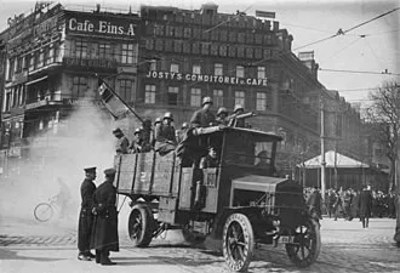
The rightist forces were spurred to action by government moves to implement a reduction in the size of the country’s armed forces imposed by the powers that had defeated Germany in World War 1.
Emboldened by these events, right-wing Freikorps units carried out a coup in Berlin on March 13, driving the SPD-led coalition government into flight from the capital and installing a would-be dictator, Wolfgang Kapp.
General Strike
The leaders of the Social Democratic-led trade unions, threatened with the suppression of the movements from which they drew their power and privilege, responded with a call for a general strike against the coup. The strike was solid across the country. Army commanders in the capital and across northern and eastern Germany backed the coup and launched murderous attacks against the striking workers. In Dresden fifty-nine workers were killed. Workers organized militias, which cleared army units out of the Ruhr industrial district and fought back arms in hand in more than two dozen localities. Armed workers’ detachments gained effective control of important industrial districts.
On learning of the call by the SPD and USPD for a general strike against the Kapp putsch, the Communist Party leadership initially responded in sectarian and ultraleft fashion. The KPD initially urged workers to stand aside from the mass struggle on the grounds that working people had no stake in defending the country’s bourgeois-democratic order.
The KPD stand was rejected in practice by the working-class ranks of the party. They recognized the broad opposition to the Kapp putsch as a revolutionary opening, a chance not only to defend hard-won democratic rights but to deal the class enemy a decisive blow. Communists Party cadres played a leading role in the strike and in workers’ armed self-defense. The party’s central leadership soon endorsed this course, reversing its initial decision.
The putschist regime fell after only four days. Its rapid overthrow of the Kapp regime demonstrated dramatically the power of united working-class action. Encouraged by Kapp’s fall, militant workers continued their strike, seeking a way to end antilabor repression and the ravage of the military and of rightists under military protection.
Call for Workers’ Government
In the face of this growing pressure, Carl Legien, the reformist head of the main trade-union federation, sought to regain control over the mass movement. He proposed to leaders of the SPD and the USPD, and of other unions that they join in establishing a government of workers’ organizations, both parties and trade unions.
Although workers’ parties lacked a parliamentary majority, the legitimacy of such a government would be assured by the overwhelming working-class and popular support for the strike.
Among this government’s tasks, Legien suggested, would be a purge of counterrevolutionaries from the armed forces and leading posts in the state administration.
On March 22, the Central Bureau of the Communist Party adopted by a one-vote margin a statement declaring that since the “objective basis for a proletarian dictatorship is not yet present,” the formation “of a Socialist government excluding the bourgeois-capitalist parties” could create “favorable conditions for the proletarian masses” to prepare to take power.
Such a government, the statement said, could create a situation “where political freedom can be fully utilized, where bourgeois democracy cannot function as the dictatorship of capital.” Communists would not join such a government, but they would act toward it as a “loyal opposition” – retaining full freedom to criticize it, but refraining from attempts to overthrow it.
Subsequently, the statement was repudiated in a divided vote by the Communist Party Central Committee and the party congress. The statement was also criticized by Comintern president Gregory Zinoviev in his written report to the Second Congress on behalf of the Comintern Executive Committee. Lenin, on the other hand, held that the tactic proposed in the statement by the Communist Party of Germany was “quite correct both in its basic premise and n its practical conclusions.” Where the statement erred, in Lenin’s view, was in lending unjustified credit to the credentials of the centrist and reformist leaders of the USPD and the SPD as socialists and a defenders of democratic rights.
Missed Opportunity
The workers’ government proposal was blocked above all by opposition from the USPD. The proposal’s failure strengthened the hand of the SPD. The bourgeois government reasserted its authority; the general strike came to an end. Nonetheless, the “workers’ government” discussion reflected the conviction of millions of workers in Germany that they must achieve a revolutionary government of working people. The continuing strikes and armed actions after Kapp’s fall demonstrated workers’ capacity to fight for this goal.
The Kapp struggle provoked much debate in the KPD, mostly over the workers’ government proposal. At the Comintern congress in June-July 1920, however, there was little mention of the Kapp events. The concept of workers’ unity in action received new expression later that year through KPD initiatives for united workers’ action for their most urgent needs – an approach later termed the “united front.” •
Endnotes
- Leon Trotsky, History of the Russian Revolution, New York: Pathfinder, 1980, vol. 2, p, 206.
- See “Theses on the Conditions Under Which Workers’ Councils May be Formed,” drafted by Grigorii Zinoviev, in John Riddell, ed., Workers of the World and Oppressed Peoples, Unite: Proceedings and Documents of the Second Congress, 1920, New York: Pathfinder, 1991, vol. 2, p. 707.
- See Mike Taber, ed., The Communist Movement at a Crossroads: Plenums of the Communist International Executive Committee, 1922–23, Leiden/Chicago: Brill/Haymarket Books, 2018, pp. 179 (quoting Lenin), 479–80 (Radek), and 642 (Zinoviev).
- John Riddell, ed., The German Revolution and the Debate on Soviet Power,. New York: Pathfinder, 1986, pp. 443–52.
- Pierre Broué, The German Revolution 1917–1923, London: Merlin, 2006, p. 277.
- V.I. Lenin, “Won and Recorded,” in Riddell, ed., Founding the Communist International: Proceedings and Documents of the First Congress, March 1919, New York:Pathfinder, 1987, pp. 301–2.
- Riddell, ed., Founding the Communist International: Proceedings and Documents of the First Congress, March 1919, New York: Pathfinder, 1987, pp. 149–64 and 240.
- Ibid., p. 194.
- See Broué, German Revolution, p. 355.
- Zinoviev read the relevant passage of Lenin’s pamphlet into the record of the 1923 Third Enlarged Plenum of the Comintern Executive Committee without commenting on its significance. See Mike Taber, ed., The Communist Movement at a Crossroads: Plenums of the Communist International Executive Committee, 1922–23, Leiden/Chicago: Brill/Haymarket Books, 2018, p. 179.
- See Riddell, ed., Workers of the World and Oppressed Peoples, Unite: Proceedings and Documents of the Second Congress, 1920, New York: Pathfinder, 1991, 2 vols., pp. 19–21, 81–82.
- Riddell, ed., To the Masses: Proceedings of the Third Congresses of the Communist International, 1921, Leiden/Chicago: Brill/Haymarket Books, 2015, p. 6.
- Riddell, ed., To the Masses, pp. 1061–3; Broué, German Revolution, pp. 468–73.
- Riddell, ed., Toward the United Front: Proceedings of the Fourth Congress of the Communist International, 1922, Leiden/Chicago: Brill/Haymarket Books, 2012, p. 1171. The 1921 call for a united front is available online: scroll down to the appendix to the Theses on Tactics.
- Broué, German Revolution, pp. 615–6.
- The preceding three paragraphs are adapted from Riddell, ed., Toward the United Front, pp. 18-19.
- Ibid., p. 19.
- For conference documents, see Clara Zetkin, Fighting Fascism: How to Struggle and How to Win, ed. Mike Taber and John Riddell, Chicago: Haymarket, 2017, pp. 77–88.
- For the proceedings of the 1923 Executive Committee Enlarged Plenum, see Taber, ed., Communist Movement at a Crossroads, pp. 381–694.
- Taber, ed., Communist Movement at a Crossroads, pp. 29–30.
- Taber, ed., Communist Movement at a Crossroads, p. 479.
- Zetkin, Fighting Fascism, pp. 64–66.


